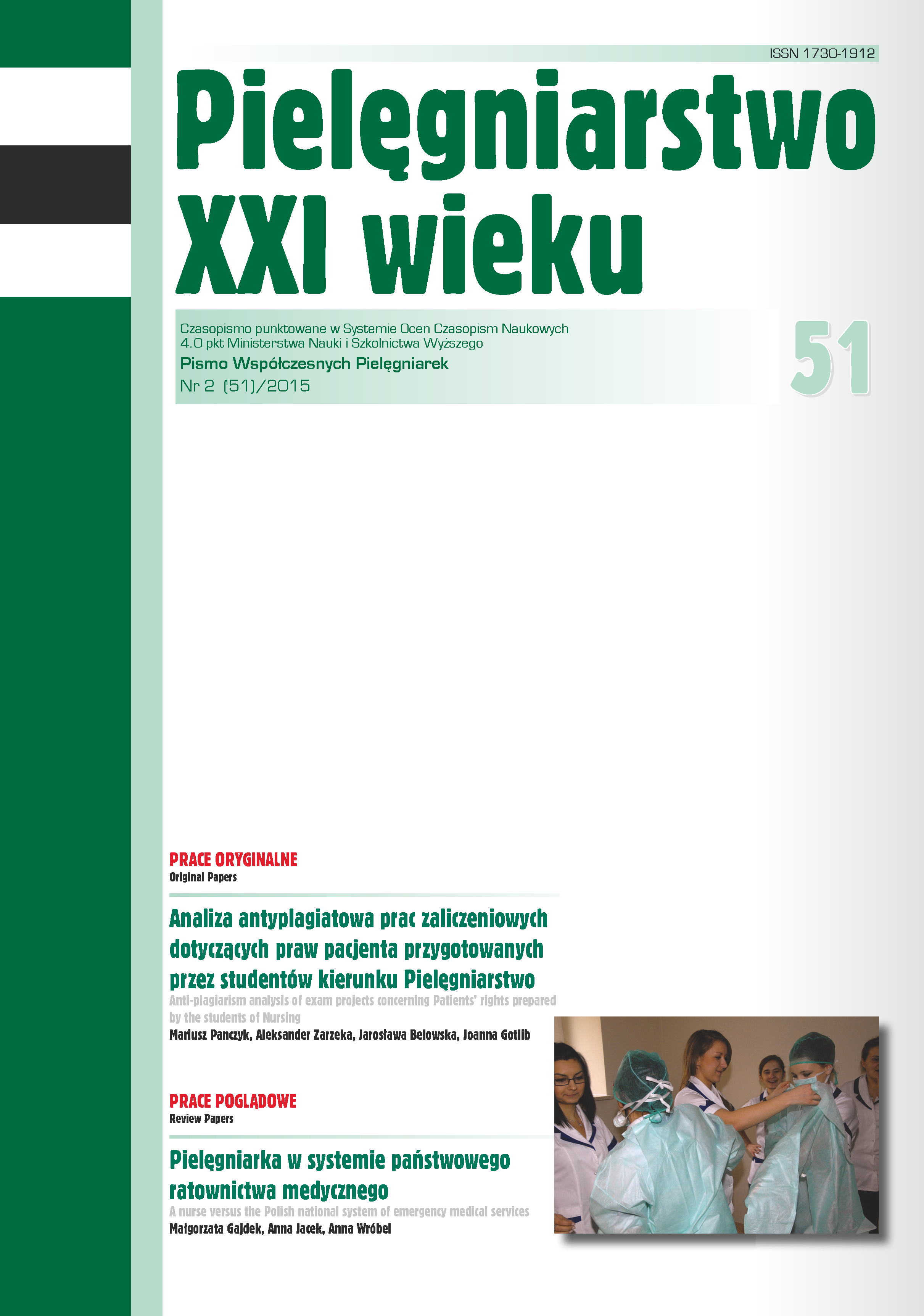Quality of life of patients with bronchial asthma treated with specific immunotherapy
DOI:
https://doi.org/10.12923/p21w-2015-2/11Keywords:
asthma, specific immunotherapy, quality of lifeAbstract
QUALITY OF LIFE OF PATIENTS WITH BRONCHIAL ASTHMA TREATED WITH SPECIFIC IMMUNOTHERAPY
Aim. Assessing the quality of life in patients with diagnosed bronchial asthma and undergoing specific immunotherapy.
Material and methods. The study looked at 55 patients diagnosed with bronchial asthma of the allergic origin. The diagnostic survey method was applied in the research, using a standardized questionnaire AQLQ(s) (Asthma Quality of Life Questionnaire) and a questionnaire compiled by the authors.
Results. The average value of the overall quality of life was 5.50 points (SD = 0.87) and it was statistically dependent on the length of period during which the symptoms of the respiratory system disease appeared (p = 0.043). The aspect of emotional functioning of patients with asthma was statistically dependent on the length of period during which the symptoms of the respiratory system disease appeared (p=0.035). Since the application of specific immunotherapy, more than a half of the respondents (58%) did not notice any deterioration of asthma symptom.
Conclusions. The specific immunotherapy that was applied had a positive impact on the quality of life of patients with asthma. The majority of respondents did not notice any deterioration of the disease symptoms, depending on the time of application of immunotherapy. Failing to visit doctors regularly, as well as short treatment intervals appeared to be the most troublesome factors for people undergoing specific immunotherapy.
References
1. Kłak A, Mińko M, Siewczyńska D. Metody kwestionariuszowe badania jakości życia. Probl Hig Epidemiol. 2012; 93: 632-638.
2. Majkowicz M, Zdun-Ryżewska A. Ocena jakości życia w zaburzeniach psychicznych. Psychiatria w praktyce klinicznej. 2009; 2: 100-114.
3. Laforest L, Pacheco Y, Bartsch P, et al. Correlates of quality of life in patients with asthma. Ann Allergy Asthma Immunol. 2005; 94: 473-9.
4. Ware JH, Hamel MB. Pragmatic trials – guides to better patient care. N Engl J Med. 2011; 364: 1685-1687.
5. Chełmińska M, Werachowska L, Niedoszytko M, i wsp. Jakość życia chorych na astmę dobrze i źle kontrolowaną. Pneumonol. Alergol. Pol. 2007; 75: 70–75.
6. Piekarska B, Samoliński B, Furmańczyk K. Stan środowiska przyrodniczego a występowanie alergii i astmy w Polsce – wyniki, ECAP. Probl Hig Epidemiol. 2009; 90: 316-321.
7. Fujita H, Soyka M, Akdis M, et al. Mechanisms of allergen-specific immunotherapy. Clin Transl Allergy. 2012, 2: 2-8
8. Kuna P. Astma oskrzelowa – epidemiologia, patofizjologia, klinika. Przewodnik Lekarza. 2002; 5: 22-31.
9. Jutel M. Patofizjologiczne podstawy immunoterapii swoistej. Postep Dermatol Alergol. 2003; 20: 124-129.
10. Szymczak W. Podstawy statystyki dla psychologów. Warszawa: Difin, 2010.
11. Stanisz A. Przystępny kurs statystyki na przykładach z medycyny. Kraków: StatSoft, 2000.
12. Dobek R, Fal A. Prewencja alergii – między unikaniem alergenów a tolerancją. Alergia Astma Immunologia. 2010; 15 (4): 175-179.
13. Gulen F, Zeyrek D, Can D, et al. Development of new sensitizations in asthmatic children monosensitized to house dust mite by specific immunotherapy. Asian Pac J Allergy Immunol. 2007; 25: 7-11.
14. Burks AW, Jones SM, Wood RA, et al. Oral immunotherapy for treatment of egg allergy in children. N Engl J Med. 2012; 367: 233-243.
15. Silny W, Czarnecka-Operacz M, Gliński W, i wsp. Atopowe zapalenie skóry – współczesne poglądy na patomechanizm oraz metody postępowania diagnostyczno-leczniczego. Stanowisko grupy specjalistów Polskiego Towarzystwa Dermatologicznego. Postep Dermat Alergol. 2010; 27: 365–383.
16. Dowbór-Dzwonka A, Cegła B, Filanowicz M, i wsp. Hipersensytyzacja na jady błonkówek. Hygeia Public Health. 2012; 47: 156-163.
17. Tukaj S, Lipińska B. Białka szoku termicznego w reumatoidalnym zapaleniu stawów: przyjaciel czy wróg? Postępy Hig Med Dosw. 2011; 65: 427-436.
18. Modrzyński M, Rapiejko P, Zawisza E, i wsp. Ocena jakości życia u chorych z alergicznym nieżytem nosa leczonych za pomocą immunoterapii swoistej. Annales Universitatis Mariae Curie-Skłodowska Lublin – Polonia. 2005; 60, Suppl. Xvi, 328. Sectio D.
19. Petersen KD, Kronborg C, Larsen JN, et al. Patient related outcomes in a real life prospective follow up study: Allergen immunotherapy increase quality of life and reduce sick days. World Allergy Organ J. 2013; 915.
20. O’Byrne PM. Global guidelines for asthma management. Summary of the current status and future challenges. Pol Archiw Med Wew. 2010; 120: 511-516.
21. Charakterystyka produktu leczniczego PURETHAL. http://leki.urpl.gov.pl/files/Purethal_mieszanka.pdf [data cytowania 12.10.2014r.]
22. Tworek D, Bocheńska-Marciniak M, Kupczyk M, Kupryś-Lipińska I, i wsp. Brak korelacji między stężeniem tlenku azotu w powietrzu wydychanym (eNO) a klinicznymi wskaźnikami nasilenia choroby i jakością życia w grupie chorych na lekką i umiarkowaną astmę oskrzelową. Pneumonol. Alergol. Pol. 2006; 74: 391–395.
23. Puchalska M, Sierko E, Sokół M, i wsp. Jakość życia chorych na raka piersi poddanych chemioterapii prowadzonej w warunkach szpitalnych. Probl Piel. 2011; 19: 331-347.
24. Yu P, Zhu G, Wu X, et al. A 6-month prospective study on efficacy safety and QOL profiles of extended-release formulation of valproate in patients with epilepsy. Seizure, 2011; 20: 23-26.
Downloads
Published
Issue
Section
License
Copyright (c) 2024 Agnieszka Gniadek, Iwona Malinowska-Lipień, Paulina Solarz, Elżbieta Marcisz (Autor)

This work is licensed under a Creative Commons Attribution 4.0 International License.




